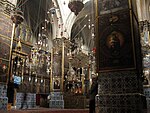Armenian Quarter

The Armenian Quarter (Arabic: حارة الأرمن, Harat al-Arman; Hebrew: הרובע הארמני, Ha-Rova ha-Armeni; Armenian: Հայոց թաղ, Hayots t'agh) is one of the four sectors of the walled Old City of Jerusalem. Located in the southwestern corner of the Old City, it can be accessed through the Zion Gate and Jaffa Gate. It occupies an area of 0.126 km² (126 dunam), which is 14% of the Old City's total. In 2007, it had a population of 2,424 (6.55% of Old City's total). In both criteria, it is comparable to the Jewish Quarter. The Armenian Quarter is separated from the Christian Quarter by David Street (Suq el-Bazaar) and from the Jewish Quarter by Habad Street (Suq el-Husur). The Armenian presence in Jerusalem dates back to the 4th century AD, when Armenia adopted Christianity as a national religion and Armenian monks settled in Jerusalem. Hence, it is considered the oldest living diaspora community outside the Armenian homeland. Gradually, the quarter developed around the St. James Monastery—which dominates the quarter—and took its modern shape by the 19th century. The monastery houses the Armenian Apostolic Church's Jerusalem Patriarchate, which was established as a diocese in the 7th century AD. The patriarchate is the de facto administrator of the quarter and acts as a "mini-welfare state" for the Armenian residents. The Armenian community has been in decline since the mid-20th century, and is in immediate danger of disappearing, according to Bert Vaux. Though formally separate from Greek Orthodox and Latin (Catholic) Christians, the Armenians consider their quarter to be part of the Christian Quarter. The three Christian patriarchates of Jerusalem and the government of Armenia have publicly expressed their opposition to any political division of the two quarters. The central reasons for the existence of a separate Armenian Quarter is the miaphysitism and distinct language and culture of the Armenians, who, unlike the majority of Christians in Jerusalem (also in Israel and Palestine), are neither Arab nor Palestinian.
Excerpt from the Wikipedia article Armenian Quarter (License: CC BY-SA 3.0, Authors, Images).Armenian Quarter
Heil HaHandasa, Jerusalem Morasha
Geographical coordinates (GPS) Address Nearby Places Show on map
Geographical coordinates (GPS)
| Latitude | Longitude |
|---|---|
| N 31.775 ° | E 35.2294444 ° |
Address
העיר העתיקה
Heil HaHandasa
9511208 Jerusalem, Morasha
Jerusalem District, Israel
Open on Google Maps










